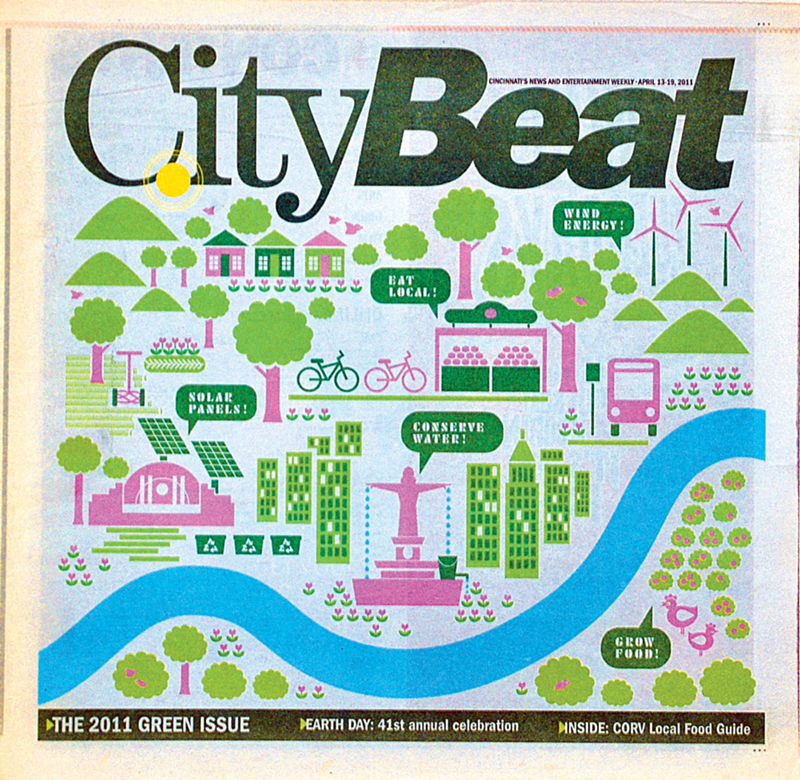A key theme of this CityBeat anniversary section is that many lifestyle choices considered “alternative” at some point in our 20 years are now fairly mainstream as Cincinnati has evolved. Count “living green” as one of those evolutions.
Government-sponsored curbside recycling was once controversial here. Mountaintop removal was an acceptable way to dig out coal. People dismissed “tree-huggers” who proposed living “sustainably” or ditching the car for other transportation options. There were maybe one or two restaurants offering vegan dishes or using farm-to-table ingredients.
Thanks to true believers who have been preaching the gospel of green since the first Earth Day in 1970, plus a new generation or two of young Cincinnatians raised on those beliefs, our community is becoming entrenched in the benefits of sustainability.
The 2011 Green Issue celebrated seven local environmentalists who’d been catalysts for change: Mark Fisher, Cincinnati Zoo’s senior director of facilities and planning who saved the organization $2.5 million in yearly energy costs via a host of cutting-edge programs; Dan Korman, owner of Park + Vine and the city’s “resident green guru;” Jess Linz of Queen City Bike, who helped the city pass its 2010 Bicycle Transportation Plan; Brewster Rhoads, who started Paddlefest in 2001 to honor the region’s largest natural resource, the Ohio River; Jim and Eileen Schenk, who’d run Imago for 30 years as a unique ecological education center in Price Hill; and Valerie Taylor, creator of the Cincinnati Locavore blog that promoted locally grown farm produce, city chickens and other urban agriculture concepts.
Writer Chris Charlson also profiled local artists who “upcycled” a variety of waste items into new products with higher environmental value, creating jewelry, furniture, paper and clothing. And the Green Issue listed 100 local earth-friendly nonprofits, retail stores, events, markets and restaurants as well as public transit agencies and cool green spaces.
Excerpt:
“ ‘I think there’s a growing awareness that the key to our region’s economic future is the businesses, government, organizations and residents becoming much more energy efficient — producing less waste, recycling and educating kids on the importance of being environmentally responsible,’ Brewster Rhoads says. ‘The greener our region is perceived, the more likely we’ll be to attract and retain the type of industry and business we need.’ ”
Today:
Here’s one indication of how Cincinnati has continued to embrace the “importance of being environmentally responsible”: Mark Fisher’s job title at the zoo is now Vice President of Facilities, Planning and Sustainability. He’s been getting national recognition this year for the zoo’s 6,400-panel solar array in its annex parking lot on Vine Street, which generates a chunk of the zoo’s electricity. Cincinnati Zoo was CityBeat readers’ pick for Best Friend to the Environment in the 2014 Best of Cincinnati issue, its fifth year in a row.
Dan Korman and corps keep on rocking the free world at Park + Vine, now offering a daily lunch counter menu and Sunday brunch. They’ll be the starting point for an all-vegan Thanksgiving Progressive Dinner on Main Street Nov. 20.
The 15th annual Paddlefest returns June 18-20, 2015 with concerts, clinics, gear swap and more at Coney Island, highlighted by canoe and kayak races and float trips on the Ohio River to Sawyer Point downtown.
Queen City Bike continues to drive conversation in town about making Cincinnati more bike-friendly, advocating for street safety, offering regular classes and helping organize Bike Month (see “2008” on page 20). Likewise, Imago continues to spark interest in earth-friendly lifestyles, working regularly with school and Scout groups and even renting space for private “eco parties.”
Cincinnati Locavore has expanded beyond the blogosphere — as today’s world demands — to Facebook, Twitter and Pinterest, sharing recipes, news, photos and links to other local earth-friendly organizations.
Seems that modern Cincinnati might be sustainable after all.


